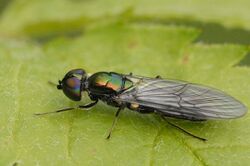Biology:Sargus iridatus
| Sargus iridatus | |
|---|---|

| |
| Scientific classification | |
| Domain: | Eukaryota |
| Kingdom: | Animalia |
| Phylum: | Arthropoda |
| Class: | Insecta |
| Order: | Diptera |
| Family: | Stratiomyidae |
| Subfamily: | Sarginae |
| Genus: | Sargus |
| Species: | S. iridatus
|
| Binomial name | |
| Sargus iridatus | |
| Synonyms | |
Sargus iridatus, the iridescent centurion, is a European species of soldier fly.[6][7][8]
Description
The body length is 6.0 to 11.0 mm. Like Sargus cuprarius, it is almost entirely purple. It has black antennae, the third segment of the antenna in males being shorter than the second. It has a whitish proboscis; the face and frons are metallic green. There are two clearly delineated white spots at the base of the antennae better developed in females. The thorax has blue reflections. It has black legs, with knees barely paler. The wings are uniformly smoky. It has dirty yellowish halteres. The abdomen is less violet, with black sternites.[9][10][11] [12]
Biology
It is found in open and wooded habitats. Larval habitats are in dung, decomposing vegetable matter and compost.
Distribution
Its distribution covers western Europe, northern, and southern Europe, north up to Finland and European Russia.
References
- ↑ 1.0 1.1 Scopoli, I.A. (1763). Entomologia carniolica exhibens insecta carnioliae indigena et distributa in ordines, genera, species, varietates. Methodo Linnæana. Vindobonae [= Vienna]: Trattner. pp. [30] + 420 pp. https://www.biodiversitylibrary.org/item/209872#page/5/mode/1up. Retrieved 23 June 2021.
- ↑ 2.0 2.1 Meigen, J. W. (1822). Systematische Beschreibung der bekannten europaischen zweiflugeligen Insekten. Hamm: Dritter Theil. Schulz-Wundermann. pp. x, 416, pls. 22–32. https://www.biodiversitylibrary.org/item/49298#page/7/mode/1up. Retrieved 14 April 2019.
- ↑ Villers, C.J. de (1789). Caroli Linnaei entomologia Vol. 3. Lugduni [=Lyon].: Piestre & Delamolliere. pp. 657 pp., 4 pls.
- ↑ Schiner, I.R. (1855). "Diptera Austriaca II. Die osterreichischen Stratiomyden und Xylophagiden". Verhandlungen der Zoologisch-Botanischen Gesellschaft in Wien 5: 613-682.
- ↑ Bezzi, M. (1903). "Orthorrhapha Brachycera. 396 pp. In Becker, T., Bezzi, M., Bischof, J., Kertesz, K. & Stein, P. (eds.)". Katalog der palaarktischen Dipteren 2: 1–396.
- ↑ Stubbs, Alan E; Drake, Martin (2014). British Soldierflies and their allies (an illustrated guide to their identification and ecology) (2 ed.). Reading: British Entomological and Natural History Society. pp. 528 pp, 20 plates. ISBN 9781899935079.
- ↑ Woodley, N.E. (2001). "A World Catalog of the Stratiomyidae (Diptera)". Myia 11: 1-462. https://www.researchgate.net/profile/Norman-Woodley/publication/303225468_A_World_Catalog_of_the_Stratiomyidae_Insecta_Diptera/links/5eac5d63299bf18b958e19bf/A-World-Catalog-of-the-Stratiomyidae-Insecta-Diptera.pdf. Retrieved 7 December 2022.
- ↑ Zeegers, T.; Schulten, A. (2022). Families of Flies with Three Pulvilli: Field Guide Northwest Europe. Graveland: Jeugdbondsuitgeverij. pp. 256pp. ISBN 9789051070682.
- ↑ Seguy. E. Faune de France Faune n° 13 1926. Diptères Brachycères.308 p., 685 fig.
- ↑ George Henry VerrallStratiomyidae and succeeding families of the Diptera Brachycera of Great Britain- British flies (1909)BHL Full text with illustrations
- ↑ E. P. Narchuk in Bei-Bienko, G. Ya, 1988 Keys to the insects of the European Part of the USSR Volume 5 (Diptera) Part 2 English edition. Keys to Palaearctic species but now needs revision.
- ↑ William Lundbeck Diptera Danica. Genera and species of flies Hitherto found in Denmark. Copenhagen & London, 1902-1927. 7 vols
 This article incorporates text from this source, which is in the public domain.
This article incorporates text from this source, which is in the public domain.
Wikidata ☰ Q7423987 entry
 |

